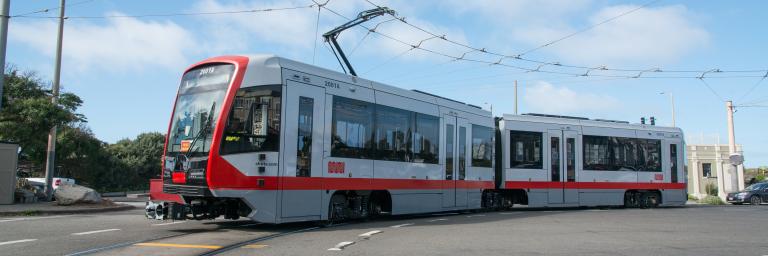As of 2024, Muni Metro is the United States' third-busiest light rail system, operating a fleet of 151 light rail vehicles (LRV) with an average weekday ridership of 173,500 passengers.
Learn more about our Muni Metro lines:
Learn about the Muni Metro subways:
What’s the difference between a Muni Metro stop and a station?
In addition to subway stations, there are 24 elevated Muni Metro “stations” on the street. These are considered stations because the entire boarding area is an elevated platform, just like underground. The N Judah stop at 4th and King streets, and the T Third stop at 4th and Brannan streets are examples of on-street Muni Metro stations.
Other Muni Metro stops on the street are indicated by a boarding island that may or may not include a shelter, or a yellow-banded painted on a utility pole.
Muni Metro Accessibility
All subway and on-street stations are wheelchair accessible. In addition, many on-street stops are also wheelchair accessible, often with a ramp leading up to a small platform for boarding.
Muni Light Rail Facilities
Muni Metro has two rail yards for storage and maintenance:
- Green Yard or Curtis E. Green Light Rail Center is located adjacent to Balboa Park Station and serves as the outbound terminus for the J Church, K Ingleside and M Ocean View. The facility has space for repairs, an outdoor storage yard and larger car house structure. The facility was renamed for former Muni head Curtis E. Green in 1987.
- Muni Metro East opened in 2008 and is located on Illinois and 25th streets in the Potrero Hill neighborhood, a block from the T Third line.
- The Cameron Beach Yard was originally named the Geneva Yard. Opened in 1902 as a Market Street Railway facility, it had a large brick office building, adjoining power house and separate car house. The original office and power house structures remain, although unused by Muni. A new shed, or canopy, was built and dedicated to Cameron Beach, who had been a member of Muni's Board of Directors. The current yard has a body and paint shop, and houses Muni's F Market & Wharves historic streetcars.
Rail Vehicle Maintenance Group
The Rail Vehicle Maintenance group is responsible for providing clean, safe and reliable rail vehicles for Muni Metro service.
Rail Vehicle Maintenance is responsible for maintaining over a hundred Breda light rail vehicles, over 50 historic rail vehicles and approximately 40 cable cars. This group provides direct on-vehicle maintenance including:
- Daily cleaning and servicing of the vehicles
- Scheduled preventive maintenance and inspection
- Repairing defects in the mechanical, electrical, electronic or pneumatic systems
- Removing and replacing worn or defective components
- Body work
- Painting
In addition to direct vehicle maintenance the Rail Vehicle Maintenance group maintains a full-service machine shop with two satellite locations, electric motor shop, sheet metal shop, electronic shop and an HVAC repair shop. These support shops repair and overhaul components that have been removed from the vehicles and fabricate new components when necessary. The support shops provide support to the rubber tire fleet, cable car infrastructure as well as light rail vehicles and historic vehicles.
Muni Metro History
On February 18, 1980, the Muni Metro was officially inaugurated, with weekday N Judah service in the Market Street Subway. Muni Metro service was implemented in phases, and the subway was served only on weekdays until 1982.
The K Ingleside began using the Market Street subway on weekdays on June 11, 1980, the L Taraval and M Ocean View on December 17, 1980, and the J Church on June 17, 1981.
Meanwhile, weekend service on all five lines (J Church, K Ingleside, L Taraval, M Ocean View and N Judah) continued to use historic vehicles on the surface of Market Street to the Transbay Terminal. The Market Street subway was closed on weekends.
On September 19, 1982, streetcar service on the surface of Market Street was discontinued and weekend service on the J Church, K Ingleside, L Taraval, M Ocean View and N Judah was temporarily converted to buses.
On November 20, 1982, the Market Street subway began operating seven days a week. Since then, Muni Metro service expanded along the waterfront south of the Embarcadero and onto Third Street where it now terminates at the city boundary.
On April 7, 2007, T Third service began between Sunnydale and 4th and King streets. Then, in 2023, the SFMTA inaugurated a new subway tunnel – Central Subway – and began T Third Muni Metro service from Sunnydale to Chinatown in the newly completed Central Subway. This new subway tunnel added new Muni Metro connections at 4th and Brannan, Yerba Buena/Moscone Center, Union Square and Chinatown/Stockton Street.
Learn more about future visions for Muni Metro, with our Muni Metro Modernization page. Visit our Muni History page for more information about San Francisco's transit.
